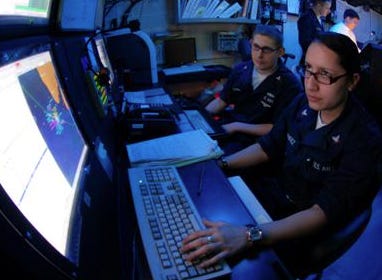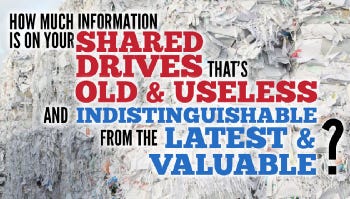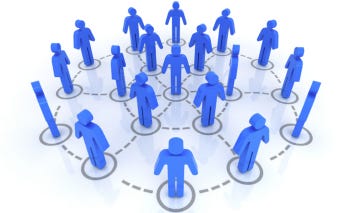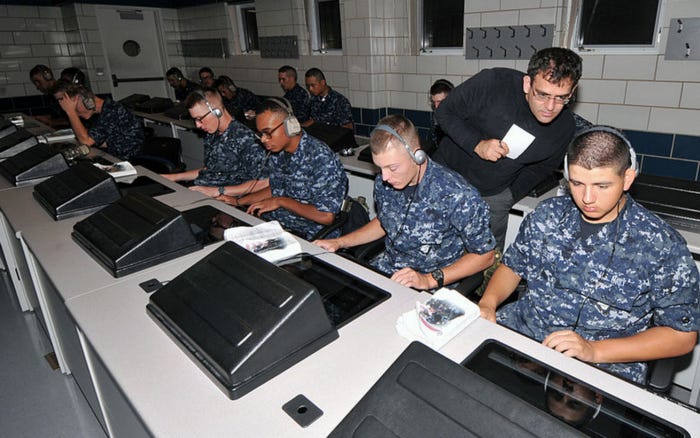It has been about 20 years since the strong leadership of Vice Admiral Jerry Tuttle and the Space and Naval Warfare Command (then Capt. John Gauss) led a true revolution in the area of Navy Command and Control. Legacy NTDS/ACDS displays of green and white were complemented with new tactical workstations (7 MIPS was fast in 1990!) running evolutionary C++ code that was started by two very smart Yale Graduates. The Joint Operational Tactical System (JOTS) was chosen to be the baseline for the Navy and future DOD Global Command and Control System (GCCS). Programmers rode ships alongside tactical watch officers and the timeline between requirements definition, software development, test, and evaluation was collapsed to a real-time 7–10 day process. There was a great cohesive government-industry team that rode ships, understood requirements, and collaborated with real fleet users to develop a strong partnership to enhance and build new features into the Navy’s C4ISR system of applications.
“Nearly a generation since its inception, C4ISR seems to lag in the way we view the tactical and strategic picture. The C4ISR corpus of information is limited by program acquisition fragmentation and baggage of gate reviews. On the technical side, there is a lack of data replication across bandwidth-limited platforms, a lack of portable, mobile data input, and structured data formatted interoperability issues. Despite consistent industry and system acquisition efforts, advancements in current C4ISR systems, including data analytic engines and additional widgets/applications, lack the soul of that quintessential complete collaboration and all-source correlation experience. It is also fair that the DOD cybersecurity issues have become the topic of the day and the Navy is flooded with audits and assessments.
Machine Learning + Social Collaboration
The time has come when, with just a few questions, knowledgeable watch operators can build rapport, navigate the conversation and draw insights. This can result in unexpected outcomes but ultimately delivers on decision-maker desires…even when the leadership does not know what questions to ask.
By contrast, the current state of C4I relies on a combination of searches bound by simple keywords and limited website filtering to fulfill the decision maker’s request. A proper balance of the interplay between “user empowerment” and overall system administrator control (or hardwired rule sets). Many man-hours are used to gather the information that is housed in hard drives or archived away in multiple, disconnected databases of flat files.
“The solution”
Today’s Big Data 2.0 technology has introduced “expert C4ISR widget/applications powered by Machine learning technologies and Social Collaboration to offer the C4ISR Consumer a natural dialogue-driven assistance to help arrive at the best possible C4ISR decision.”
“The applications will draw data from underlying sources like tactical organic and inorganic information, enemy threat data, past fleet histories, enemy historical data, open-source intel/data, relevant publications, policies, news feeds, and publications and social media to give C4ISR operators and decision-makers a highly unified, enhanced, enriched and C4ISR experience.”
“Imagine a carrier battle group commander, making a decision”
“online” today with the benefits of machine learning and all-fleet collaboration architecture. The commander’s staff would visit several websites/blogs, social feeds, and “find” (vice search) for knowledge by narrowing down factors using various attributes (both legacy and dynamic search parameters), style, tags, and a pre-determined list of features. Compare that to the legacy one-way GCCS-M experience of only getting input from the battle group staff ?” C4I has become a multitude of Chat windows on the user’s display. The near future is Machine learning-enabled applications blended with the secure enterprise-wide social collaboration which will aid decision-makers to make this same query online in plain English (or natural language translation) to find the best course of action/solution as well as unexpected items needed to complete the mission.”
“The benefit”
“By empowering the fleet to engage in machine learning and social collaboration as they choose, Fleet C4ISR applications powered by machine learning + social enhance C4ISR system(s) to foster a more operator-led, non-linear, ubiquitous analysis and command and control experience that turns fleet operators into knowledge managers and experts. Replicating the best of the C4I experience online in collaboration mode is like putting a fleet tactical expert in the hands of every ship commanding officer.”
Some great examples of Machine Learning can be found in IBM Watson.
The Power of Social Collaboration
The commercial market is exploding with Social Business and the power of collaboration within business enterprises. Despite the current bandwidth issues of maritime satellite communications (getting better every day), the US Navy is exploring the addition of social business to compliment today’s legacy communication framework of email, document sharing, chat, and expensive teleconference tools.
The emergence of Generation D (D for Digital), mobile devices, wireless networks “everywhere”, and the consumerization of information technology is having a current impact on the naval enterprise.
There are some key points around social collaboration/business:
(1) “You are as smart as your network”
Think of it this way, you may not know the answer to every question, but your network (and your network’s extended network) knows the best possible answer from the organization.
Working connected (collaboratively) you become a smarter sailor because you can tap into the knowledge, insights, and experience of Subject Matter Experts who can help provide answers to problems.
Here is the mindset: (you’ve all heard this before) “it’s not about what you know, it’s about what you share”.. and if you share knowledge to help others, others will share knowledge to help you — this is about creating circles of service where the more everyone contributes and shares, the more everyone benefits… most importantly the fleet>
Think of Social Collaboration as a network of networks = people connected to people. The more people that participate, the smarter we all become as a Navy community (2) “Use social to leverage the hierarchy (and not be hindered by the hierarchy)”
This is about using Social Business/Collaboration to connect with people across teams and various management/organizational levels/commands to solve problems (i.e. SPAWAR, Fleet Forces, Staffs, Ships, Industry, Labs, Universities). Flattening the organization. Social Business is a democratizing and organization flattening environment. We all sit in different places, yet Social Business/Collaboration tools and working social can bring any of us together around a problem or around a shared challenge, into a wired team for a specific task. In the hierarchy, everyone is equal, everyone can participate, everyone can contribute, everyone can share. All this causes organizational flattening where what’s important, is ideas and great ideas can come from anywhere and anyone.
Social Collaboration and the hierarchy is not automatic
In enterprise social business (like LinkedIn or Twitter or G+ or any social platform) = you get out of it what you put into it.
It’s very important to understand that Social Collaboration enables people go get things done with people who have knowledge and expertise around a particular area (it doesn’t matter where you may find them in an org chart on paper) Similar to comments about life on an aircraft carrier made by Charlene Li in her book “Open Leadership”. Organizations can share and have flattened command and control to share information. This does not mean that chain of command goes away for the decision-making time period of a management decision or battle management process. Social Business allows for command and control and structured workflow/business processes when the decision process is started.
Solving problems, being smarter, being agile. If you don’t know the answer to something, there is probably someone who does….Engage your network, your communities and ask for help, ask for ideas, ask for inputs…
The system commands, Navy labs, and other fleet assets will see your ask and jump in to help… the more that happens, the smarter we become as a Navy organization AND the more agile the Navy focuses on being a better warfighter (in the spirit of RAD- Reduction in Administrative Distraction).







Crazy that I wrote this 11 years ago while at IBM. Remember G+